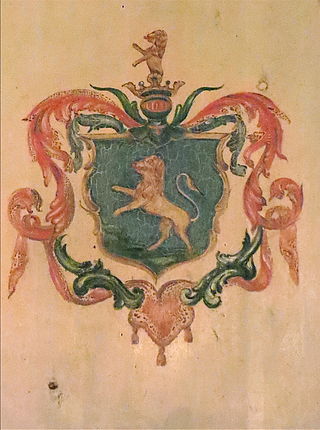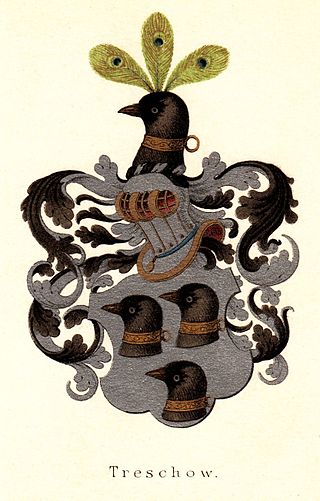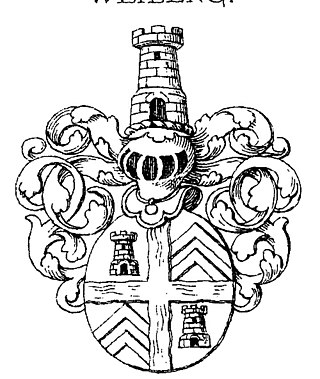
The Gyldenkrantz family was a Danish and Norwegian noble family of Dutch origin. The family became patrilineally extinct after some generations. [1]

The Gyldenkrantz family was a Danish and Norwegian noble family of Dutch origin. The family became patrilineally extinct after some generations. [1]
Joachim Christian Gertsen Geelmuyden (1730-1795) was born in Nordhordaland and grew up in Bergen, Norway. He belonged to a family of officials; his father was a parish priest and an official and his grandfather was a merchant. The Geelmuyden family was originally from the Netherlands. Joachim Geelmuyden attended Bergen Cathedral School in 1746 and continued in 1749 with theology studies. By 1752 he had also completed law studies, but without graduating. [2]
In 1754 he became Vice-City Manager of Bergen. He continued in 1755 as notarius publicus. In 1758 he was General Manager of Customs in Bergen and Stavanger. In 1760 he was awarded cand.jur. by the University of Copenhagen. In 1765 he became General Commissary of War and in 1766 he became City Manager of Bergen. Joachim Geelmuyden was a wealthy man, owning properties in Bergen as well as Damsgård Manor (Damsgård hovedgård). He married in 1753 Elisabeth Both (22 June 1731 – 6 May 1800), together with whom he had the son Hans Both Joachimsen Geelmuyden (10 July 1759- 8 May 1813). [3] [4]
On 29 January 1783 Joachim Geelmuyden and his family were ennobled under the name Gyldenkrantz ' meaning "Golden Wreath". Their son Hans Gyldenkrantz (1759- 1813) entered into marriage with Frederikke Louise von Linstow (27 June 1759 – 20 August 1788), who was the daughter of Hartvig Christoph von Linstow and Cathrine Eleonore Fredrichsdatter Lohmann in Bergen. The couple had a son Joachim Christian Gyldenkrantz the younger (1786–1845).

Description: In the first of four fields, on a red shield a golden laurel wreath. In the second field, on a blue shield three (one over two) six-pointed golden stars. In the third field, on a green shield a brown hart rampant. In the fourth field, on a golden shield seven (four over three) silver balls. On the helm a noble coronet, and up from the coronet a brown hart rampant. Supporters: a bear to the dexter and a wolf to the sinister.
Before the ennoblement, Joachim Gyldenkrantz used the Geelmuyden arms, which display on a green shield a brown hart rampant three (one over two) six-pointed golden stars.

Galtung was a Norwegian noble family dating from the ennoblement of Lauritz Galtung in 1648. However, when he was ennobled, documents indicated the family descended from an older noble family, the Galte family. This led to both Hardanger families being referenced as Galtungs in history books.

Damsgård Manor is a landmark manor and estate in Bergen, Norway. It is noted for its distinct rococo style and is possibly the best preserved wooden building from 18th-century Europe.

Hother Erich Werner Bøttger was a Norwegian architect.

Johan Lausen Bull was a Norwegian jurist, politician and land owner.

The Løvenskiold family is a Dano-Norwegian noble family of German origin. Members of the family now live primarily in Norway. Originally named Leopoldus, it was one of the first patrician Norwegian families to buy noble status, in 1739, when it was also granted the surname Løvenskiold.

The Count of Wedel-Jarlsberg is a title of the Norwegian nobility and of the Danish nobility. The family of Wedel-Jarlsberg is a branch of the larger family von Wedel, which comes from Pomerania, Germany. Family members have had a significant position in the 18th and 19th centuries' Norwegian history.

The Treschow family is a noble family originating in Denmark and with branches in Norway and Sweden. The family name means "wooden shoe-maker" and the family later counted many merchants in the 17th century and priests in the 18th century. A member of the family, Michael Treschow, bought the status of untitled (lower) nobility in Denmark in 1812, although Norway, where he was resident, abolished the concept of nobility only a few years later. Members of this family have been industrialists and landowners, notably in Vestfold.
Arent Greve was a Norwegian jeweler, goldsmith and painter.

The Knagenhjelm family is a Danish and Norwegian noble family originating in Norway.

The Von Munthe af Morgenstierne family is a Danish and a Norwegian noble family living in Norway. It descends from Bredo Munthe of Bekkeskov, who on 19 December 1755 was ennobled under the name von Munthe af Morgenstierne. The family is included in the Yearbook of the Danish Nobility.

The Svanenhielm family was a family of Danish and Norwegian nobility.
The Falsen family, also de Falsen, is a Danish and Norwegian noble family.

The Gyldenpalm family was a Danish and Norwegian noble family.

The Werenskiold family, also spelled Werenschiold, Wærenskiold, Werenskjold etcetera, is a Danish and Norwegian noble family living in Norway.

The Gyldenstjerne family, also spelled Gyldenstierne and in Swedish Gyllenstierna, is a Danish, Norwegian, and Swedish noble family divided into various branches and ranks. It is one of the oldest noble families in Scandinavia. The family surname appears, in the form of Guildenstern, in William Shakespeare's tragedy The Tragedy of Hamlet, Prince of Denmark. The surname should not be confused with Gyldensteen, the name of another short-lived Danish noble family, first recorded in 1717 and which became extinct in 1749.

Rosenvinge is a Danish and Norwegian noble family.

Bartholomæus Deichman was a Danish/Norwegian clergyman and Bishop.
Hans Hansen Lilienskiold was a Norwegian jurist, government official, civil servant, and land owner. He was a member of the Lilienskiold noble family and served as County Governor of Finnmark. He is particularly remembered as an author for his works on the topography and culture of Finnmark.

Hans Jacob Scheel was a Dano-Norwegian Major-General.

Niels Hertzberg was a Norwegian priest and politician.